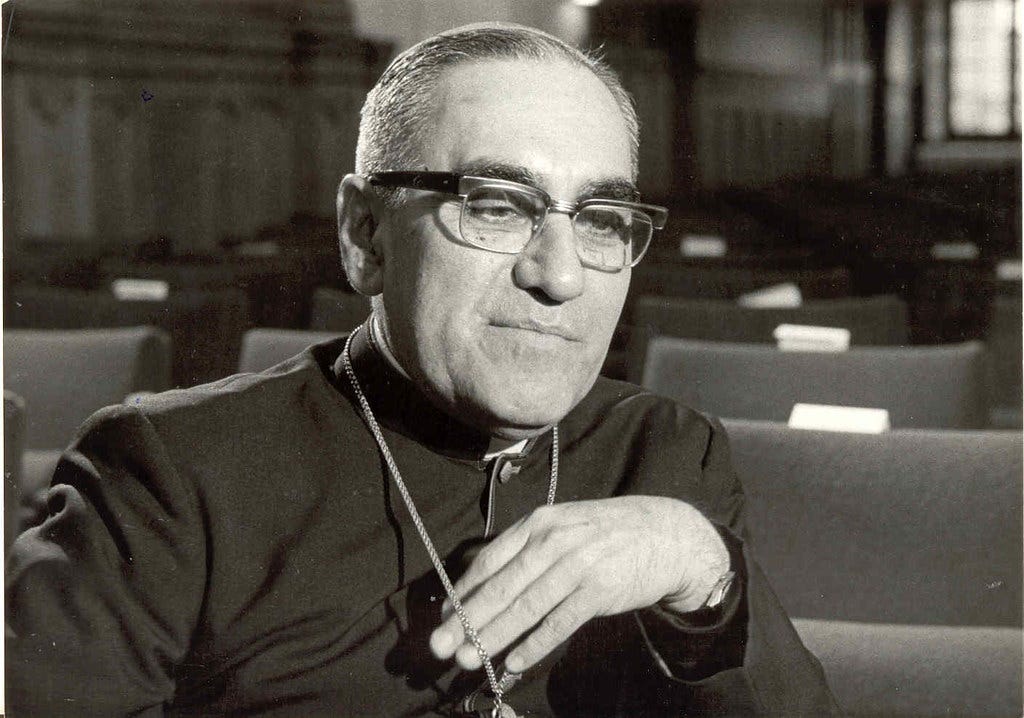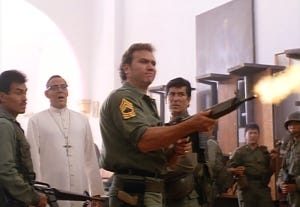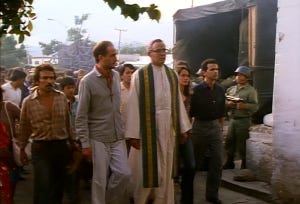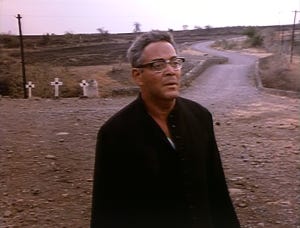Romero: Prayer in Hours of Darkness
The film Romero covers the three years that Romero served as Archbishop of San Salvador. In that period, Romero underwent a conversion from accepting the status quo in El Salvador to championing the rights of the people, and especially of the poor, to be free of violence and oppression. His efforts led to encounters with the military, the political establishment, the guerrillas, and the campesinos. Importantly, the film frequently depicts Romero as relying on prayer to build up the community, to maintain his own strength, and to remind himself of his dependence on God. There are two powerful scenes in the film that I think show this: the military occupation of the church at Aguilares and Romero’s prayer at the crossroads.
The movie is 23 years old, but still, spoilers ahead
Prior to his appointment as Archbishop, Romero was considered a political and religious conservative, someone unlikely to challenge the status quo in which the Church was aligned with the oligarchy and the government. It is only the murder of his close friend and fellow priest Rutilio Grande, SJ that brings the violence and injustice in El Salvador to his attention. Grande’s assassination came less than three weeks after Romero’s installation.
Following Grande’s death, Romero demanded the government investigate. Because of the state’s refusal to do so, Romero famously refused to attend any state functions involving the President until such an investigation was conducted. It never was. In the film, Romero’s decision not to attend the President-elect Humberto’s inauguration leads Humberto to retaliate by closing the church at Aguilares (Grande’s home church). Indeed, not only is the church closed, but it is turned into a military barracks.
When Romero arrives at the Church, there is a throng of people outside – including the young Jesuit priests Osuna and Morantes. They look frustrated, angry, resigned – but not exactly hopeful that Romero can do much. The archbishop enters the church, telling the army he is there to remove the eucharist from the tabernacle. He is not there to agitate, nor to fight, nor to reclaim the church. Nonetheless, the hulking commanding officer takes his machine gun and shoots the crucifix, the tabernacle, the altar, all with perverse glee. Romero leaves the church, walks back to his car, but instead of getting in he returns to the church, walks right past the officer, and starts picking up the host off the floor. The officer again shoots, trying to scare Romero, and then has him thrown out. Again, Romero walks to his car, but this time he gets in and drives off. Twice he appears to be leaving his church – the people – behind. By this point, one might start wondering if Romero is Peter, with a third denial coming.
But he returns a third time. He gets out of the car, puts on his vestments and his stole, and begins to process into the church with the recovered eucharist. Now the Jesuits and the people join him. As they walk to the entrance, the soldiers train their weapons on them. Yet here, Romero’s face shows his determination, and it mirrors the faces of the people. This time it is the soldiers who back down, and Romero and the people retake the church. On coming to the altar, Romero turns to the people and says:
We are here today to retake possession of this church building and to strengthen all those whom the enemies of the church have trampled down. You should know that you have not suffered alone, for you are the church. You are the people of God. You are Jesus in the here and now. He is crucified in you, just as surely as he was crucified 2000 years ago on that hill outside Jerusalem. And you should know that your pain and your suffering, like his, will contribute to El Salvador’s liberation and redemption.
Romero’s dress, the procession, and his turn to the people at the front of the church reference the beginning of the mass. From this, it seems reasonable to infer that this statement is not a pep talk for the people but rather the beginning of their prayer. He prays with the people in the midst of a church with military cots where there should be pews and bullet holes where there should be a tabernacle. Despite the small victory of retaking the church building, they are still an oppressed people at risk of violence. Nonetheless, Romero’s form of resistance to injustice is based on prayer, not violence.
Yet this conviction will be tested for Romero. Later, the situation has only gotten darker: Fr. Osuna has been killed by the military while Fr. Morantes has taken up arms, seeing violent struggle as the only response left. In pain over the continuing violence and injustice, Romero walks to the intersection where Grande was killed. This literal crossroads evoke the spiritual crossroads Romero finds himself in: the path one of his priests has taken means giving up his hope for peace, but the other path means he is marching to his own death. Falling to his knees, Romero prays:
I can’t…
You must…
I’m yours…
Show me the way.
Here Romero prays, in his own way, the same prayer of Jesus in the Garden of Gethsemane: “My Father, if it is possible, let this cup pass from me; yet not what I want but what you want.” (Mt 26.39). Romero does not seek death; he wishes only to follow the path God lays out for him. In this moment of private, personal anguish, Romero turns to prayer as an expression of his trust in God.
Archbishop Romero highlighted the central role of prayer in his own life. In a homily he gave on March 2nd, 1980, a mere three weeks before his own assassination, he said
Yesterday, when a journalist asked me where I found inspiration for my work and my preaching, I told him: ‘Your question is very timely, for just now I have come from my retreat. If it were not for this prayer and reflection with which I try to stay united with God, I would be no more than what St. Paul says: clanging metal.
As we continue our Lenten journey, perhaps we might take anew from Romero’s own life the important role of prayer in reminding us of our relationship with and dependence on God. And as we approach the 33rd anniversary of Romero’s martyrdom, may we all pray for an end to violence, persecution, and injustice in our world.








